
Station Name: DUNSTABLE NORTH
|
| Date opened: | First station 1.6.1846, 2nd station January 1866 |
| Location: | West side of High Street North (A5) |
| Company on opening: | London & Birmingham Railway & London & North Western Railway |
| Date closed to passengers: | January 1866 & 26.4.1965 |
| Date closed completely: | 9.10.1967 |
| Company on closing: | British Rail (London Midland Region) |
| Present state: | The South Bedfordshire District Council offices occupy the site. No evidence of the station remains. One bridge abutment survives on the east side of A5. |
| County: | Bedfordshire |
| OS Grid Ref: | TL011226 |
| Date of visit: | 27th December 2010 |
Notes: The passing of the Dunstable & London & Birmingham Railway Act on 30th June 1845 authorised the construction of a short branch line from Leighton Buzzard to connect Dunstable with the London & Birmingham's main line. The line opened for freight on 29th May 1848 and to passengers on 1st June. A station was opened on the west side of Watling Street (A5). The London & Birmingham built a one-road engine shed at the terminus which opened on 1st June 1848 and closed in 1859. Initially services were worked by the LNWR from Dunstable until 1st September 1860, when the Luton - Hatfield line was opened and the Great Northern Railway took over the entire branch from Welwyn. The GNR did not use LNW facilities at the shared station, and eventually a 45ft GNR turntable and loco siding were put in c.1883, surviving until the end of steam.
The site of the original Dunstable station became the goods yard, with a large brick goods shed on the site of the old terminus and an adjacent 5-ton crane. This yard handled large quantities of coal and fertilisers in addition to general traffic. To the south of the yard lay the town's gasworks which were served by sidings, whilst to the west was a signal box which controlled access to the yard as well as the level crossing over Brewer's Hill Road. A rail-served Bedfordshire County Council depot was situated on the other side of the level crossing immediately to the north of the running lines. Other sidings served Waterlow's printing works, the Great Northern coal yard and cattle pens from 1871 and the Associated Portland Cement works at Houghton Regis from 1925. Due to subsidence a new 50-lever signal box replaced the LNWR one from 16th August 1958; it was to have only a short life as closure came just over a decade later on 23rd March 1969. At this time the station was still lit by gas lamps. Passenger traffic over the Dunstable branch in its later years was not great except on market days, and Dunstable North, as it became on 1st July 1950, was closed to passengers on 26th April 1965 and to goods on 9th October 1967. The station buildings were quickly demolished and the track was lifted in 1968. The line to Leighton Buzzard closed from 1st January 1966, with track lifting at Dunstable beginning in 1968. The former Great Northern coal yard which was sited on the east side of Watling Street became an oil storage depot in October 1968 which, together with the cement works, was served by between one and three trains daily.
The site of the station and goods yard is now the offices of South Bedfordshire District Council. What remains of the line to the west has become part of the 2.2 mile Sewell greenway from French's Avenue to just short of Stanbridgeford. The route is part of National Cycle Network route 6 and includes a bridge over the A505. There is no actual evidence of the station at the site although the council have built a half-circular low brick wall to commemorate the station on the site of the old turntable. Unfortunately they haven't included an interpretation board so visitors must wonder why the wall has been built Today Dunstable, with a population of roughly 33,000, has the unfortunate honour of being one of the largest towns in the South East not to have a railway station. Click here here for memories of Dunstable North station 1942 - 1965 BRIEF HISTORY OF THE LEIGHTON BUZZARD TO WELWYN GARDEN CITY LINE
Nothing was done until 1844 when a meeting was held in Luton. By now there was mounting opposition to the scheme which would have to cut across the 'Great Moor', a large area of undeveloped common land close to Luton. This angered George Stephenson who vowed that Luton would not get a direct railway connection to London as long as he lived. Although the Luton line was not built in Stephenson's lifetime (he died in 1849), a branch line to Dunstable received Royal Assent on 30th June 1845 with the passing of the Dunstable, London & Birmingham Railway Act which authorised a line between Leighton and Dunstable. Inevitably a meeting was held in Luton to discuss proposals from local businessmen to build a line from Luton to the new line at Dunstable once it was completed. Many people preferred a counter proposal for a direct line between London and Manchester passing through Luton, which would be 14 miles shorter for passengers travelling to London, avoiding the need for a change of trains at Dunstable and Leighton. Another option was to build a branch to the Great Northern Railway's London to York line which was already under construction and would pass 12 miles to the east of Luton. The direct route was chosen as the best option which, at that time, left Luton without a railway while other branch lines in the area were already being planned and built.
On 3rd July 1854 the Hertford & Welwyn Junction Railway received parliamentary authority to build a line from the North Eastern Railway at Hertford to the GNR at Digswell, and on 30th September 1854 there was a proposal to extend this line across the GNR to Luton and Dunstable linking three established railway companies (NER, GNR & LNWR). Not wanting to be left out, the GNR offered to work the line between Hatfield and Luton although it was not prepared to provide any finance.
The Luton, Dunstable & Welwyn Junction Railway Act was passed on the 16th July 1855 authorising a junction with the LNWR at Dunstable and a triangular junction with the GNR at Digswell together with a bridge over the GNR to allow through running over the H & WJR between Hertford and Dunstable. All three companies were authorised to work the line. A single track was built (with the intention of doubling in the future) with construction starting on 16th October 1855 which, in Luton, was designated as a half-day public holiday as residents had waited so long to get a railway!
Work on the Luton line had been progressing during the amalgamation negotiations, and at a shareholders’ meeting on 6th August 1857 it was announced that the first section of the line between Luton and Dunstable was ready for goods traffic. Several goods wagons were fitted with seats to take shareholders along the line. The line was initially inspected on 18th March 1858 and, after a turntable was provided at Leighton at the request of the Board of Trade inspector, the line was passed a month later, with a goods service running from 5th April 1858 and a passenger service from 3rd May 1858; large crowds travelled to Luton station for a day to take part in the celebrations and ride on the new line. Initially there were five trains in each direction on weekdays only; two of these were later extended to Leighton. At this time Luton trains used a new station in Church Street, Dunstable, with through trains to Leighton bypassing the LNWR station which was at a lower level. Initially an end-on connection had been proposed which would have required raising the level of the road by three feet to provide a level crossing. This was rejected by Parliament, so a diversion was authorised in 1856 taking the new line over Watling Street, rejoining the Leighton line to the west of Dunstable station. A proposed new station at the junction was not built at that time, although through trains from Luton could back into the LNWR station if required.
There was a junction with the GNR at Welwyn, but no station was provided, and the H & WJR station at Welwyn Junction was closed with trains on both lines terminating at Hatfield. In 1864 there were six daily down trains between Hatfield and Leighton, with five up trains. There were a further two down trains between Luton and Leighton in the early morning with two up trains in the afternoon and evening and one train in each direction between Hatfield and Dunstable. On Sundays there were two down trains between Hatfield and Dunstable, with one up train with two short-running services. The Hertford, Luton & Dunstable Railway was absorbed by the GNR under the Great Northern Railway Act of 12th June 1861. This gave the GNR exclusive rights to operate the line, although a clause in the Act gave the LNWR joint rights to use the section between Dunstable and Luton. In December 1868 new parallel lines into Hatfield were brought into use for the branch services, and the earlier junctions were removed in January 1869. Although built as single track throughout, it was always the intention that the line would be doubled, and sufficient land was acquired over some of the route. In the late 1890s the Great Northern line between Digswell and Hatfield was widened with a new track being provided for Dunstable trains, and the old Dunstable line becoming the new down slow main line In 1890 passenger numbers were sufficiently high for doubling the line between Luton and Dunstable. This was authorised by Parliament in 1891, but progress was slow and it did not open until 10th September 1899. Proposals to double the remainder of the line brought a lukewarm response from the GNR. Passenger numbers increased through the 1890s, and by 1900 there were nine trains in each direction between Luton and Dunstable, with eight in each direction between Luton and Dunstable and seven between Dunstable and Leighton.
Through the 20th century the line remained very profitable, due in part to the large number of private sidings, in particular those serving chalk quarries near Dunstable, the sand and gravel pits around Leighton Buzzard and, later, Vauxhall Motors in Luton. Following the 1923 general grouping the Dunstable branch became part of the London Midland & Scottish Railway while the Hatfield to Dunstable line was part of the London & North Eastern Railway. This split continued after nationalisation in 1948 with British Railways Eastern Region being responsible for the Hatfield line as far as Harpenden down distant signal, with the remainder of the line coming under the London Midland Region. On 2nd April 1950 the boundary was adjusted, transferring Harpenden (East added on 25th September 1950) to the LMR. Diesel-hauled freight trains started replacing steam in February 1959, and passenger trains in June 1959, the latter being replaced with DMUs in 1962. In common with many other branch lines passenger numbers went into rapid decline in the 1950s. The Sunday service was withdrawn on 21st January 1951, but a service of seven down and five up trains between Hatfield and Dunstable was maintained until closure of the line with four trains in each direction between Dunstable and Leighton Buzzard. The passenger service between Dunstable North and Leighton Buzzard was withdrawn from 2nd July 1962 with the last 'Dunstable Flyer', as it had been nicknamed, running on 30th June. Two enthusiasts’ specials travelled along the line after closure, both arranged by the South Beds Locomotive Society: the first on 22nd September 1962 ran between Luton and Banbury and the second, the 'Cobbler Tour', on 19th September 1964, ran from Luton to Leighton Buzzard and on to Newport Pagnell, returning to Luton via the Midland main line. The line remained open for freight traffic until 1st January 1966 after which it was cut back to Grovebury sidings south of Leighton Buzzard, serving sand and gravel pits, until final closure on 5th December 1969. Track-lifting was piecemeal, starting at Dunstable in late 1968 but not reaching Stanbridgeford until July 1969. Track-lifting west of Stanbridgeford started in February 1970 and was not completed until February 1971. National Cycle Route 6 now follows what is now known as the Sewell greenway between Stanbridgeford and Dunstable.
The Hatfield line was scheduled to close on 6th January 1965 as part of the Beeching cuts. Closure was deferred following local objections - but only until 24th April when the last 'Skimpot Flyer' carried a wreath and a large number of passengers on a farewell journey along the line: it returned to Hatfield almost empty! The line remained open for freight and for goods traffic to Luton Bute Street until 26th June 1967. After that date the line between Luton and Dunstable was singled and retained to serve the Dunstable Cement works at Houghton Regis, with a new connection from the Midland main line at Luton opening in November 1965. The east end of the line was also retained for rubbish trains bound for Blackbridge sidings east of Wheathampstead. Track lifting on the remaining section between Blackbridge and Luton started at the Eastern Region/London Midland region boundary west of Harpenden East station on 8 May 1966 towards Luton and from 26th February 1967 towards Blackbridge. Blackbridge sidings closed in May 1971, and much of the track between Welwyn Garden City and Wheathampstead now forms the Ayot Greenway cycleway and footpath, with the the trackbed between Luton Hoo and Harpenden is incorporated into the 50-mile Lee Valley Walk.
In the early 2000s the South Midland Railway Group set up a base in the ex-Bedford Trucks sidings on White Lion Retail Park at Dunstable and planned to form a transport heritage centre. The site was linked to the mothballed line to Luton via an illegally reinstated connection which the group hoped to reopen in the long term. The lease of the yard, however, was not secured, and in July 2001 it was reported that the group was in dispute over their occupation of the site. The project ended when the illegal connection to the Luton to Dunstable branch line was removed in March 2001, and vehicles were removed in July 2001 and January 2002; the remaining railway vehicles on the siding were finally cut up by the council, and the tracks were lifted in 2005. In December 2003 the Department for Transport approved the Transport & Works Act submission for a £85m scheme to convert the line into a guided busway. Planning permission and a Transport & Works Order were granted in November 2006, and the Transport Minister gave the go-ahead in August 2008. Tenders for its construction were sought in July 2009.
Sources: Wikipedia (Leighton Buzzard station) and the Hatfield, Luton & Dunstable Railway by G & S Woodward (1977). Published by Oakwood Press ISBN 978-0-853614-58-6. For further reading see Hertfordshire's lost railways by Keith Scholey ISBN ISBN 1 84033231 X and Bedfordshire's lost railways by Keith Scholey ISBN ISBN 184033 271 9 and Branch Line to Dunstable by Sue & Geoff Woodward (2008) Published by Middleton Press ISBN 978-1-906008-27-7. Other web sites: Lost lines - features photos taken along the line between 1989 - 2007. BBC Beds, Herts & Bucks web site. Disused Railways web site. Click here to see an aerial view of the whole Leighton Buzzard - Dunstable line on Google Earth. All the stations are shown. Prepared by Mark Percival. Tickets from Michael Stewart & Jim Lake, route map drawn by Alan Young, Bradshaw from Chris Hind To see other stations on the Leighton Buzzard - Welwyn Garden City line click on the station name: Leighton Buzzard, Stanbridgeford, Dunstable Town, Chaul End, Luton Bute Street, Luton Hoo, Harpenden East, Wheathampstead, Ayot, Welwyn Garden City Halt (first station) & Welwyn Garden City (second station) |
c1950s - 30 June 1962 .
north_old2.jpg)
Copyright photo from John Alsop collection

The line serving Dunstable cement works is seen to the east of the station.
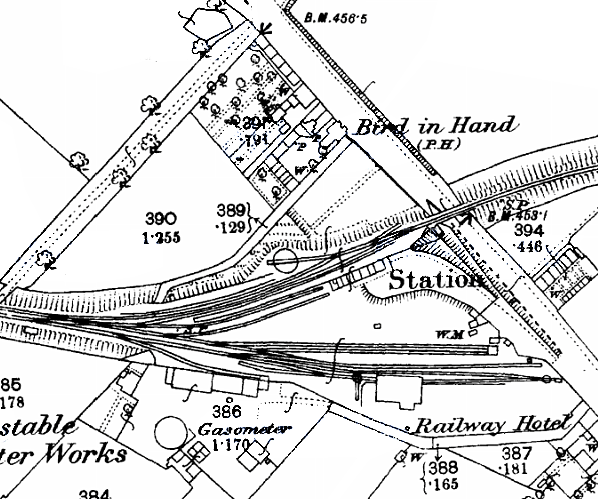
.
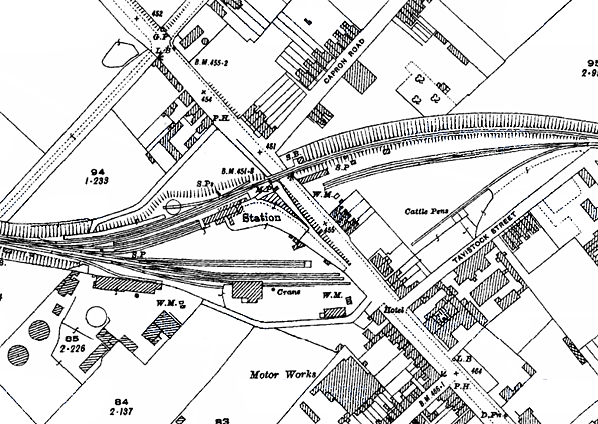
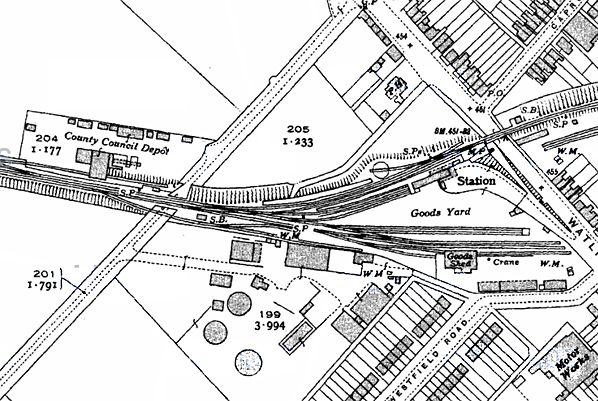
north_old1.jpg)
Copyright photo from John Alsop collection
north_old9.jpg)
Photo from John Mann collection
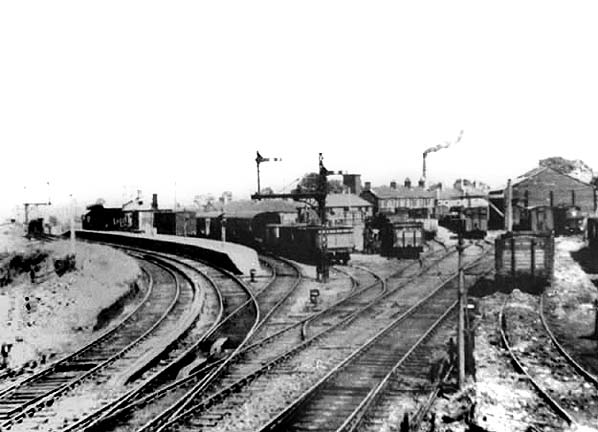
)north_old12.jpg)
is waiting in the bay platform.
Photo by John M. Cramp (from 30937 Photographic Group web site)
north_old17.jpg)
north_old25.jpg)
and Laighton Buzzard.
Photo by David Pearson
Click here for Dunstable North Station Gallery 2:
30 June 1962 - December 2010
| Last updated: Saturday, 15-Jul-2017 17:45:30 CEST |
© 1998-2011 Disused Stations
|





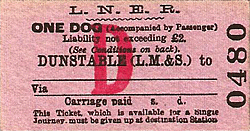




north_old6.jpg)
north_old15.jpg)

 Home Page
Home Page